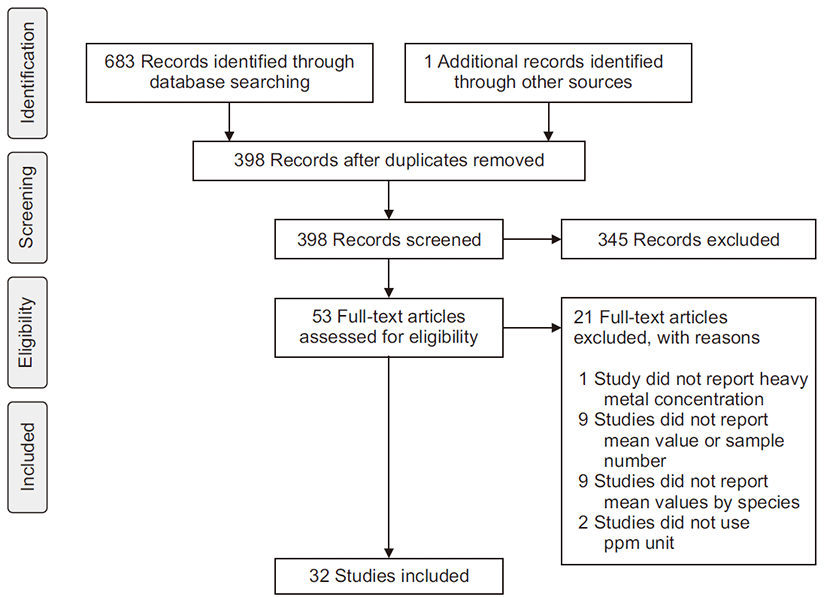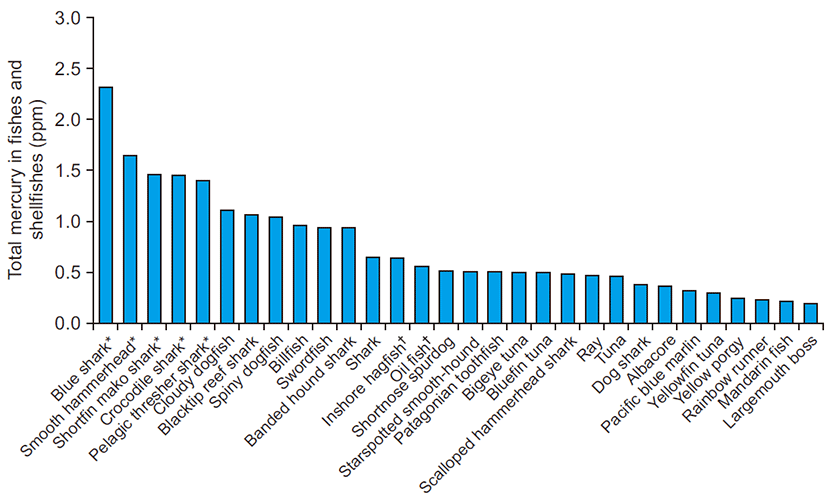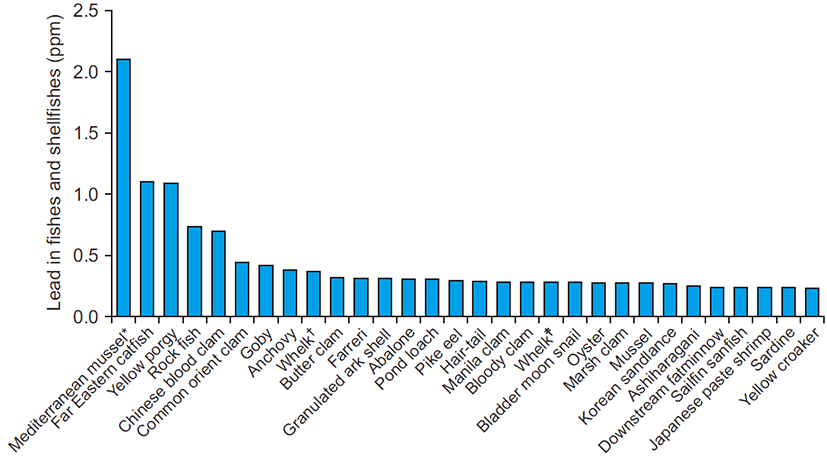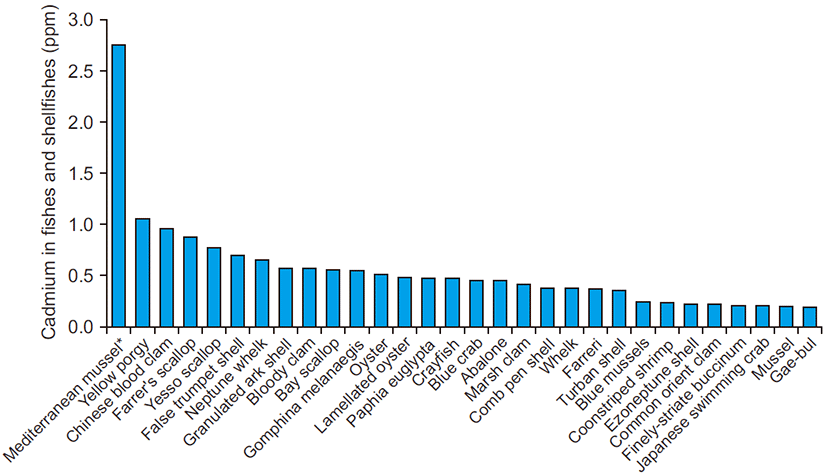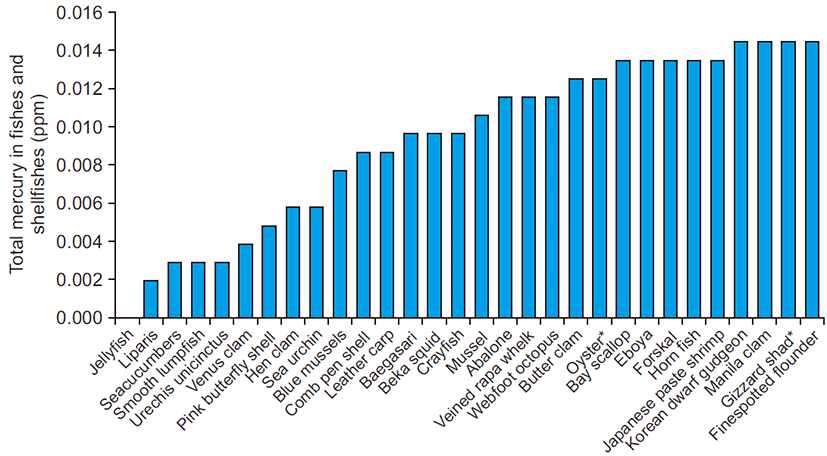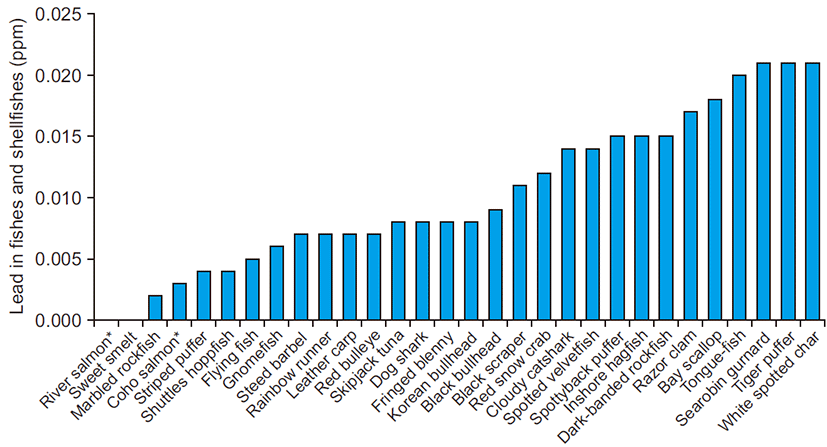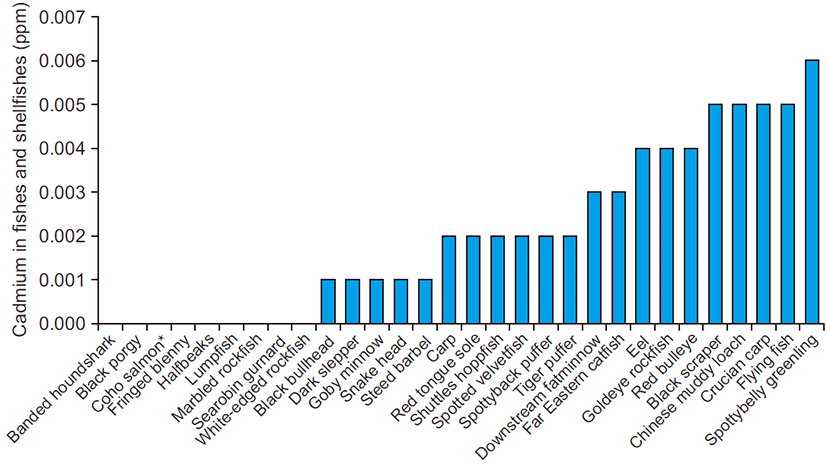Introduction
Due to heavy metal pollution across the globe, aquatic products contain heavy metals. Mercury (Hg), cadmium (Cd), and lead (Pb) are the primary heavy metals contained in aquatic products [1]. These heavy metals are reported to accumulate in living organisms [2] and cause various harmful health effects to humans such as neurophysiological dysfunction, kidney dysfunction, and decreases in bone mineral density, even at low concentrations [3-5]. Heavy metal contamination of aquatic products is transmitted to humans through food, so the heavy metal content of aquatic products has a significant impact on human health.
In Korea, 30% of all food containing protein and 80% of all animal proteins are consumed as aquatic products [6]. Aquatic products also contain various nutrients, such as selenium and omega-3 fatty acids [7]. However, since aquatic products are one of the largest sources of human exposure to hazardous heavy metals [1], there is a social concern about heavy metal contamination of marine products, and various studies have reported on the heavy metal concentrations in fish and shellfish.
Although several studies [6,8,9] have reported on the amount of heavy metals in fish and shellfish in Korea, it is difficult for researchers or the general public to obtain integrated information on the heavy metal content in fish and shellfish in Korea due to data is not found in one source.
Therefore, this study aims to present comprehensive data on the amount of heavy metals in fish and shellfish in Korea through a systematic review of studies that have investigated and reported on that issue.
Methods
To search for articles written in English and Korean, we conducted comprehensive database searches of the literature published from January 1998 to September 2017 using three databases: PubMed, Korean Studies Information Service System, and Research Information Sharing Service. The search terms for PubMed included fish OR shellfish OR seafood AND mercury OR cadmium OR lead OR heavy metal AND Korea. The search terms for Korean Studies Information Service System and Research Information Sharing Service included eoryu sueun, eoryu kadeumyum, eoryu nab, eoryu jung-geumsog, paeryu sueun, paeryu kadeumyum, paeryu nab, paeryu jung-geumsog, eopaeryu sueun, eopaeryu kadeumyum, eopaeryu nab, and eopaeryu jung-geumsog. The bibliographic records were imported, duplicates were removed, and the articles were screened to ensure that they met the inclusion criteria.
The titles and abstracts of the articles were screened by one investigator (SY) to ensure that they included English or Korean-language studies that reported original data on the three heavy metals (total Hg, Pb, and Cd) concentrations in fish and shellfish in Korea. Reviews were included at this level. Two investigators (SY and JS) independently screened the studies using exclusion criteria, and then they extracted the data. The following exclusion criteria were used to screen the articles: 1) did not report the three heavy metals concentrations; 2) heavy metal concentration unit is not convertible to ppm; 3) did not report the heavy metal concentration based on the type of fish and shellfish species; and 4) did not report the numbers or mean values of the analytical samples.
In the selected articles, the number of species samples examined, the means, the standard deviation, and the minimum and maximum values were extracted and summarized. After unifying the fish and shellfish species on the basis of Korean names, scientific names, or English names, the average of each heavy metal concentration in the same species was calculated from the data collected from several articles using the number of samples and mean values (formula 1). When recalculating the averages using formula 1, undetectable values were considered as zero.
Results
After removing duplicate records, 398 bibliographic records were identified. Among these records, 345 articles did not meet the inclusion criteria at the first screening, 53 full-text articles were selected for full-text screening, and 32 articles were obtained and screened. Information about the searching and screening process, and the study inclusion criteria are summarized in the PRISMA (Preferred Reporting Items for Systematic Reviews and Meta-Analyses) flow diagram presented in Fig. 1.
Studies that examined the concentrations of three heavy metals, Hg, Pb, and Cd, in fish and shellfish in Korea are summarized in Supplementary Table 1. The number of samples analyzed, and the mean, standard deviation, and minimum and maximum values of the total Hg, Pb, and Cd concentrations in fish and shellfish reported in the selected literature are summarized in Supplementary Tables 2, 3, and 4, respectively. Of the 32 articles that reported on the concentrations of heavy metals in fish and shellfish, 15 reported Hg concentrations [10-24], 12 reported heavy metal concentrations for Hg, Pb, and Cd [6,8,9,25-33], and 5 reported Pb and Cd concentrations [34-38]. The mean values for each of the heavy metal concentrations for the same species were calculated using the data collected from several articles (Supplementary Tables 5-7).
Figs. 2, 3, and 4 present information on 30 kinds of fish and shellfish with high total Hg, Pb, and Cd concentrations, respectively. The concentration of total Hg tended to be higher in predatory fish, such as sharks, billfishes, and tuna, while the concentrations of Pb and Cd tended to be higher in shellfish. The criteria for heavy metal concentrations in fish and shellfish used by the Korea Food and Drug Administration (KFDA) are as follows: total Hg concentration should be below 0.5 ppm for all fish and shellfish, except deep sea fish, tuna fish, and billfish. The concentration of methyl Hg in deep sea fish, tuna fish, and billfish should not exceed 1.0 ppm. All fish and shellfish should have Pb concentrations below 2.0 ppm, and the concentration of Cd should be 2.0 ppm or less in shellfish. After considering the concentration of methyl Hg in deep sea fish, tuna, and billfish as being 70% of the total Hg concentration [15], fish and shellfish with concentrations of heavy metals that exceed the KFDA standards were identified. Total Hg was higher than the KFDA standards in inshore hagfish and oil fish (Fig. 2). Concentrations of methyl Hg were higher than the KFDA standards in blue sharks, smooth hammerheads, shortfin mako sharks, crocodile sharks, and pelagic thresher sharks (Fig. 2). Concentrations of Pb and Cd were higher than the KFDA standard in Mediterranean mussels (Figs. 3, 4). Therefore, among the fish and shellfish with relatively high concentrations of heavy metals it is necessary to be particularly careful about consuming those that exceed the KFDA standards.
Figs. 5, 6, and 7 illustrate 30 kinds of fish and shellfish with low total concentrations of Hg, and low Pb and CD concentrations, respectively. Among the 30 kinds of fish and shellfish with low total concentrations of Hg, oysters and gizzard shads are known to contain high levels of omega-3 fatty acids (Fig. 5). Among the 30 kinds of fish and shellfish with low concentrations of Pb, river salmon and Coho salmon are known to contain high levels of omega-3 fatty acids (Fig. 6). Among the 30 kinds of fish and shellfish with low concentrations of Cd, Coho salmon is known to contain high levels of omega-3 fatty acids (Fig. 7).
Discussion
The concentration of Hg was higher in predatory fish and the concentrations of Pb and Cd were higher in shellfish. Several types of fish and shellfish exceeded the KFDA heavy metal standards. Inshore hagfish and oil fish exceeded the KFDA standards for total Hg; blue sharks, smooth hammerheads, shortfin mako sharks, crocodile sharks, and pelagic thresher sharks exceeded the KFDA standards for methyl Hg; and Mediterranean mussel exceeded the KFDA standards for Pb and Cd. Thus, as the results of this study demonstrate, some types of fish and shellfish may be highly contaminated by heavy metals.
However, fish and shellfish also contain the most biologically active form of omega-3 fatty acids, docosahexaenoic acid and eicosapentaenoic acid. Pacific saury, hairtail, chub mackerel, Spanish mackerel, anchovies, oysters, gizzard shad, Atka mackerel, salmon, Bluefin tuna, swordfish, and trout are known to contain high concentrations of omega-3 fatty acids [39,40]. With the exception of Bluefin tuna and swordfish, which have high concentrations of Hg, hairtail, which has a high concentration of Pb, and oysters, which have high concentrations of Pb and Cd, the present study found that other types of fish were relatively low in heavy metals. According to the results of the study, salmon and gizzard shad had low concentrations of all three types of heavy metals. Consequently, the present study can be used as a basis for recommending foods with high nutrients and low concentrations of Hg, Pb, and Cd.
Of the papers that reported on the concentrations of heavy metals in fish and shellfish, most of the studies reported on Hg concentrations, while only a few reported on Pb and Cd concentrations. Fish and shellfish are major sources of Pb and Cd; therefore, further research is needed. In addition, further research on the levels of other contaminants, such as arsenic, methyl Hg, and endocrine disruptors, such as persistent organic pollutants, are also needed in the future.
This paper is the first to present a comprehensive summary of articles that investigated the concentrations of heavy metals (Hg, Pb, and Cd) in fish and shellfish. The findings could be used as evidence to protect Koreans from exposure to heavy metals due to the consumption of highly polluted aquatic products. The findings could also be useful for health researchers investigating the effects of exposure to heavy metals.
Supplemental Materials
Supplementary Tables are available from: https://doi.org/10.12771/emj.2018.41.1.1.
Supplementary Table 1. The reviewed studies that examined the concentrations of three heavy metals (Hg, Pb, Cd) in fish and shellfish
Supplementary Table 2. Mean, SD, Min, and Max values of the total Hg concentrations in fish and shellfish reported in the reviewed articles
Supplementary Table 3. Mean, SD, Min, and Max values of the Pb concentrations in fish and shellfish reported in the reviewed articles
Supplementary Table 4. Mean, SD, Min, and Max values of the Cd concentrations in fish and shellfish reported in the reviewed articles
Supplementary Table 5. Mean values of the total Hg concentrations calculated by species from the mean values reported in the reviewed articles
Supplementary Table 6. Mean values of the Pb concentrations calculated by species from the mean values reported in the reviewed articles
Supplementary Table 7. Mean values of the Cd concentrations calculated by species from the mean values reported in the reviewed articles
